2017 KTM 1090 Adventure review: more is better !

The 1050 Adventure, launched in 2015, became 1090 Adventure two years later, with a power leap of 30 hp. Now assisted by a "Low Power" version for A2 licenses, this KTM trail family access bike multiplies the assets to seduce. Test.
KTM 1090 Adventure test page 3: MNC technical point
Engine
Despite its name change – from 1050 Adventure in 2015 to 1090 Adventure in 2017 – the entry-level KTM trail uses the same engine, down to the cubic centimeter (1050 cc): a V-twin open at 75 ° , common to all large-displacement KTM. This dual-ignition engine (two spark plugs per cylinder) and double overhead camshaft is a bored version of the 1190 Adventure trail.
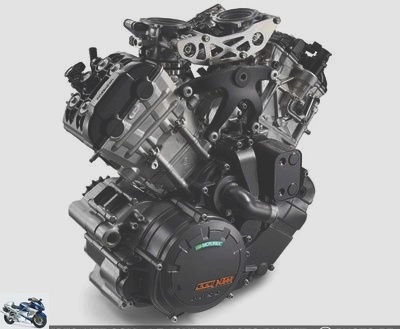
Its dimensions are 103×63 mm, which places it in the category of supercar engines. Its high compression ratio of 13 to 1 also betrays its sporty temperament. Passed to Euro4 standards via a revised exhaust and mapping, this V-twin develops 125 hp at 8,500 rpm and 109 Nm at 6,500 rpm, i.e. 30 hp and 2 Nm of torque more than when it came out in 2015.
This huge performance gain is due to the fact that the previous version was deliberately restricted – via camshafts and specific injection – to meet the constraints of the A2 license. For 2017, KTM changes strategy: the engine now delivers its full potential, while a new version "L" (for "Low Power") limited to 35 kW (47.5 hp) is appearing for the new permits.
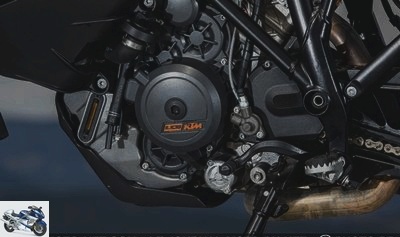
Keihin injection is controlled by a ride-by-wire accelerator, while the clutch is actuated by a hydraulic control – adjustable in spacing – connected to a multidisc in an oil bath. To prevent the rear wheel from jamming during downshifts, KTM has equipped it with an anti-dribble.
Regarding maintenance, KTM announces service intervals every 15,000 km and valve clearances every 30,000 km. Or the same recommendations as for the bestial 1290 Super Adventure.
Cycle part
The cycle part of the 1090 Adventure is strictly identical to the old 1050 Adventure, starting with its tubular trellis frame in steel reinforced with chrome molybdenum. A chassis common to the entire KTM range, compact and light (9.8 kg on the 1090). The rear loop – with integrated case mounts – is made of aluminum, like the hollowed out swingarm.
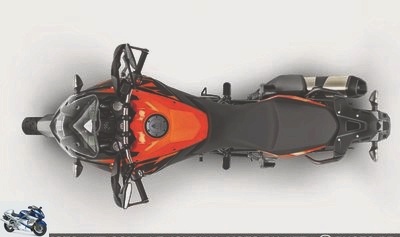
Faithful to the trail spirit, the 1090 Adventure frolic on 185 mm at the front and 190 mm at the rear via WP suspensions (KTM brand). At the front, the inverted fork 43 mm in diameter offers no adjustable, not even in preload. The mono-shock absorber can for its part be adjusted in rebound and also in preload, using the wrench provided in the tool kit. However, it lacks a remote adjustment wheel for duo outings.
Braking is based on Brembo 4-piston calipers and 320mm discs up front and a 267mm disc clamped by a 2-piston caliper at the rear. The absence of a radial master cylinder is felt, with a feeling at the right lever quite spongy. The rear offers for its part an excellent dosage and a very correct power. Too bad this efficiency is tarnished by too rapid intervention of the ABS …
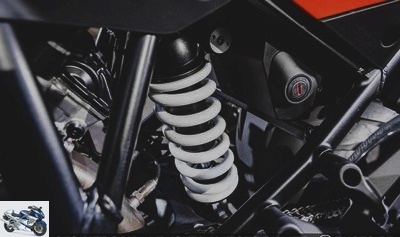
The wheelbase is 1560 mm and the ground clearance to 220 mm, two values guaranteeing stability and real ability to climb. The saddle height suffers on the other hand from this off-road DNA, with 805 mm to be stepped over… The width contained in the 19 and 17 inch stick rims is responsible for maintaining agility with 110 mm at the front and only 150 mm in back.
The advertised weight is 228 kg with 23 liters of gasoline in the tank, or 10 kg less than the 1290 Super Adventure S. This is both little and a lot, given the differences in equipment and fairings between the two Austrian trails (the 1190 Adventure disappears from the catalog in 2017).
Electronic
In addition to the ride-by-wire electronic accelerator cited above, the 1090 Adventure receives as standard three driving modes (Rain, Street and Sport), selectable from the left stalk. These modes influence both the responsiveness of the accelerator and the sensitivity of the traction control: in "Rain" mode, the acceleration is smoothed out – but the 125 hp all remain present – and the traction control. comes very early. It’s the opposite in "Sport" mode.
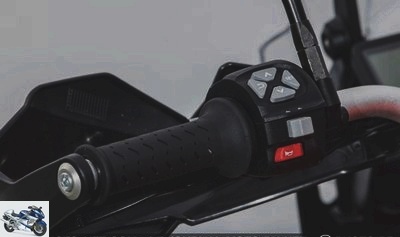
Its braking is assisted by a Bosch 9M + two-channel, disconnectable ABS. Less sophisticated than the ABS of the 1290 Adventure, the central unit of the 1090 does not include a coupling function (the front and rear brakes are independent) and is not sensitive to the inclination of the motorcycle.
Likewise, the anti-slip – disconnectable – is not informed about the angle. It works by comparing the rotational speed of the wheels, and by analyzing the parameters managed by the ride-by-wire (throttle opening, engine speeds, gear engaged, etc.). This more basic method does not prevent it from offering excellent reactivity and a commendable smoothness of operation, in "Rain" mode as in "Sport" mode..

Note that a fourth driving mode – "Off-Road" – is available as an option at € 287: it allows the intervention of the ABS and traction control to be postponed (100% slippage allowed). The action of the ABS on the rear is also deactivated to allow the rear wheel to be locked, a frequent action in off-road use..
The instrumentation is identical to 2015: it is in the form of two LCD screens flanking a needle tachometer. Complete and easy to read, it provides information – on the right – on the fuel level, the time, the gear engaged, the speed and the driving mode. On the left, the second screen presents, among other things, the air temperature, two trips, autonomy, average and instantaneous consumption, battery voltage..
Related articles
-
Test Triumph Tiger 1200 XRT and XCA 2018: ready for the road adventure Electric window, keyless start, hill start assistant, directional lights,…
-
2017 KTM 1090 Adventure review: more is better ! The 1050 Adventure, launched in 2015, became 1090 Adventure two years later, with a power leap of 30 hp….
-
2018 Triumph Tiger 800 XCA and XRT test: smart vision Does the imposing Triumph Tiger 1200 intimidate you? Opt for the Tiger 800 2018: more accessible…
-
2018 BMW F 750 GS and F 850 GS test: which one to choose ? In 2018, the BMW F750GS and F850GS gain in displacement and technology to succeed the F700GS…
-
2017 Suzuki V-Strom 1000 XT test: a super cost ! The Suzuki V-Strom 1000 , relaunched in 2013 after a career suspension in 2008 due to Euro 3 standards,…
-
2017 KTM 1090 Adventure review: more is better ! The 1050 Adventure, launched in 2015, became 1090 Adventure two years later, with a power leap of 30 hp….
-
2017 Kawasaki Z1000SX review: a super bike for the road Kawasaki is taking advantage of the changeover to Euro 4 to refine its Z1000SX on many fronts:…
-
2017 KTM 1090 Adventure review: more is better ! The 1050 Adventure, launched in 2015, became 1090 Adventure two years later, with a power leap of 30 hp….
-
Test BMW R1200GS Rallye 2017: an option towards Adventure How to renew the success of the R1200GS, a motorcycle which dominates – even crushes – its…
-
KTM 1290 Super Adventure S test : maxi-trail maxi performance ! Only two years after its release, the KTM 1290 Super Adventure is evolving in depth and…